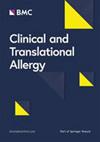LP-003, a novel high-affinity anti-IgE antibody for inadequately controlled seasonal allergic rhinitis: A multicenter, randomized, double-blind, placebo-controlled phase 2 clinical trial
Abstract
Background
Anti-IgE therapy can serve as an option for inadequately controlled seasonal allergic rhinitis (SAR) patients. LP-003, a novel anti-IgE antibody, is being tested as an add-on treatment for SAR. This trial aimed to evaluate whether LP-003 is effective and safe for SAR.
Methods
This placebo-controlled double-blind phase 2 randomized clinical trial was conducted in 17 hospitals in China. SAR patients whose symptoms were inadequately controlled despite first-line treatment (nasal corticosteroids with or without oral antihistamine) in the previous two seasons were enrolled between July 6, 2023 and August 7, 2023. Participants were randomized in a ratio of 2:4:3 to receive subcutaneous injections of 100 mg LP-003, 200 mg LP-003 or placebo every 4 weeks for 2 doses. All patients received fluticasone propionate as standard-of-care (SoC). The main outcome was the mean total nasal symptom score (TNSS) during the peak pollen period (PPP). Secondary endpoints included a series of symptom and medication scores, quality of life assessments during PPP and pollen period (PP), immunogenicity and safety.
Results
A total of 180 participants were randomly assigned. The LP-003 + SoC treatment achieved a significantly lower TNSS compared with placebo + SoC (3.31 vs. 4.06, intergroup difference = −0.74, p = 0.0464). For key secondary outcomes, the LP-003 group also achieved significantly lower daily nasal symptom and rescue medication use scores (3.54 vs. 4.42, intergroup difference = −0.88, p = 0.0352), and daily ocular symptom and rescue medication use scores (1.66 vs. 2.19, intergroup difference = −0.54, p = 0.0245) compared to the placebo group. The suppression of free IgE was prevalent and persistent. There was no statistically significant difference in adverse events and severe adverse events between LP-003 and placebo groups.
Conclusions
These findings support LP-003 as a promising add-on option to the SoC for patients with moderate to severe SAR. Fixed dosage regimen and extensive suppression of free-IgE render it a cutting-edge advantage.


 求助内容:
求助内容: 应助结果提醒方式:
应助结果提醒方式:


